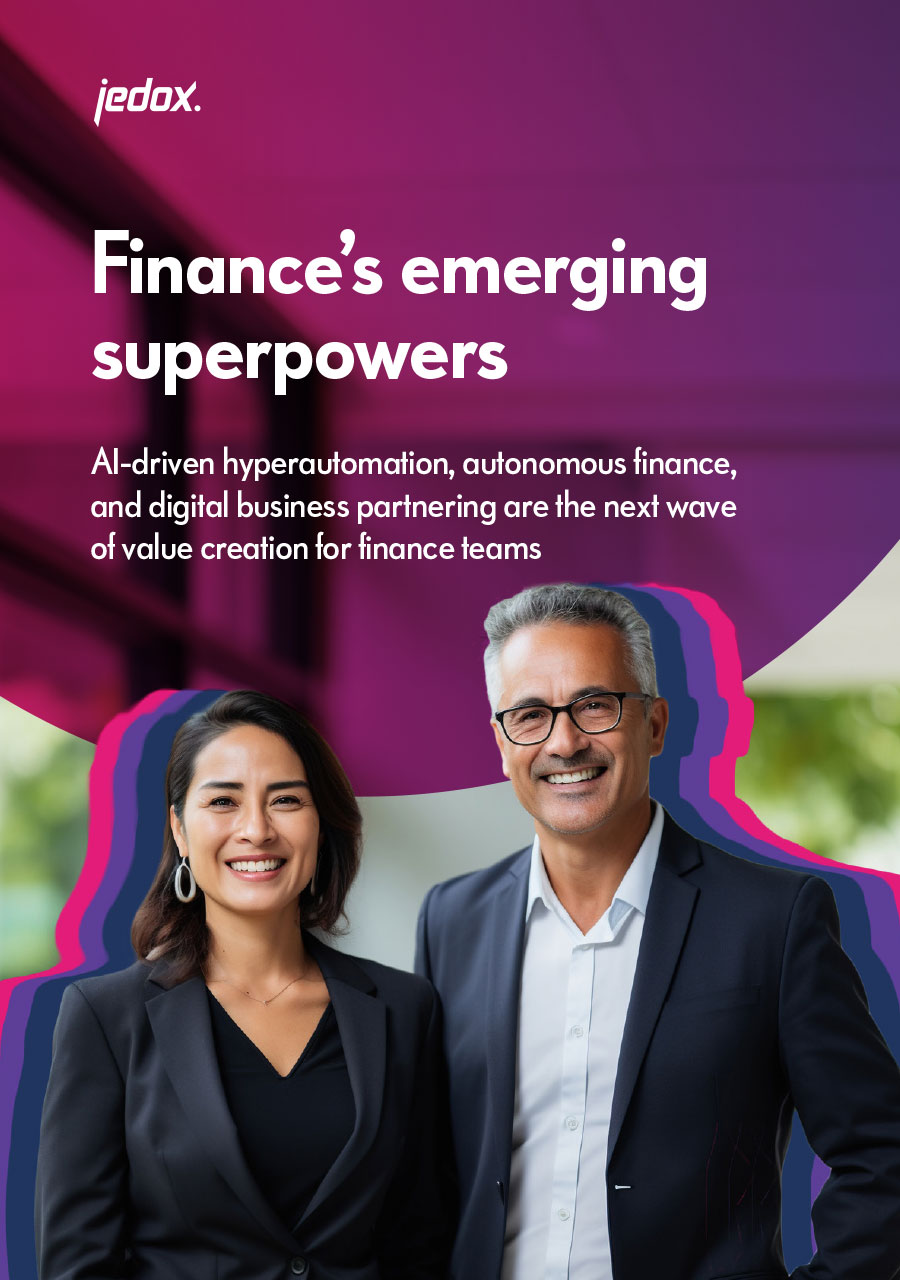
Embracing the future: The rise of autonomous finance in organizations
Autonomous finance is a revolutionary approach in the rapidly evolving world of technological and augmented tools that CFOs and heads of financial planning and analysis (FP&A) have at their disposal. Coined by industry analyst Gartner, it refers to self-learning software agents that automate business operations and corporate finances. Autonomous finance is increasingly permeating all aspects of financial management by optimizing and streamlining financial data gathering and analysis.
These new technologies are transforming financial decisions at the corporate level. Autonomous finance is especially prevalent in organizations well-versed in Business Intelligence (BI) and Enterprise Resource Planning (ERP) that use Enterprise Performance Management software (EPM).
With autonomous finance at their disposal, CFOs and heads of FP&A can make better-informed up-to-date financial decisions based on vast amounts of dispersed financial data.
What is autonomous finance?
Autonomous finance refers to the automated management of financial activities by leveraging practical artificial intelligence (AI), natural language processing (NLP) that interprets human language, and machine learning that continuously absorbs and learns from data inputs. These tools successively identify patterns and trends or detect anomalies. Autonomous finance combines them into data and algorithm-driven processes to automate financial operations and processes. They provide the bigger picture to financial managers who can harness the tools’ predictive capabilities when forming financial decisions.
With autonomous finance, repetitive, day-to-day financial activities are augmented by AI and automated by blockchain transparency and robotic process automation (RPA) to handle financial data seamlessly and securely.
This shift from manual to automated financial management is more than just a technological upgrade or a temporary fad; it represents a significant shift in how organizations interact with the economic ecosystem with little to no human intervention.
Finance has progressed rapidly from manual ledger entries and Excel sheets to sophisticated AI-driven platforms. Technological advancements, regulatory changes, and an increasing demand for efficiency and transparency in financial processes have fueled a growing demand for automated tools.
Why autonomous finance is essential for organizations
Corporate and financial enterprises are inherent users of autonomous finance because they rely heavily on data, numbers, codes, and rules that are better managed and streamlined with AI. These tools can be highly predictive and prescriptive of trends, pricing, global supply chains, bookings, and staffing.
With autonomous finance, strategic financial decisions are based on vast amounts of data and continuous automated analyses. These data points are highly accurate, relevant and current to help CFOs make informed real-time decisions.
AI financial technologies are predicted to reduce the cost of finance by 40% in the coming years and will force CFOs and leadership teams to “integrate with the rest of the organization and rethink the way work gets done”, according to Gartner.
Autonomous finance removes the day-to-day necessity of collecting, manually entering and analyzing data without cross-functional integration. It gives CFOs the bigger picture to scale customer demand. Continuously mining and analyzing financial data can translate into increased revenue.
The technology behind autonomous finance
The concept incorporates three major technologies: AI, Blockchain, and Hyperautomation.
At its core, autonomous finance is driven by AI and machine learning (ML) algorithms capable of analyzing vast amounts of data in real-time and predicting trends. When integrated with SaaS BI and CPM tools, these systems give unparalleled insights into markets and across enterprises that drive efficiency and accuracy in financial operations, offer predictions and assist in decision-making.
Who should use autonomous finance?
When teams, leadership, and stakeholders manage performances effectively, they can take decisive action, control the organization’s trajectory, and achieve greater operational efficiencies and profitability.
According to Goldman Sachs, generative AI in finance could boost the world’s economy by 7% and make people 1.5% more productive. Salesforce found that 89% of financial services leaders believe the first companies to deploy autonomous finance will carve out a sizeable competitive advantage. But who will benefit most from autonomous finance?
CFOs, FP&A, and accounting
Autonomous finance provides customizable “out-of-the-box” models with pre-built logic to prepare data automatically. For CFOs and heads of FP&A, this increases the speed and ease of planning, budgeting, forecasting, auditing, and delivering fast and accurate financial information and decisions to venture partners and stakeholders when needed. Accounting teams can collaborate better and easily synchronize, verify, and coordinate financial operations.
Corporate finance
Corporate organizations profit from automated risk assessments and real-time decision-making capabilities, significantly enhancing their financial operations’ efficiency, effectiveness, and strategic thinking.
Investors, financial institutions and banks
Individuals seek tools to optimize their financial health with minimal effort. Financial institutions look for ways to enhance decision-making accuracy and operational efficiency. Banks aim to improve customer service and internal processes.
CIOs
Tech-savvy CIOs embrace technological innovations to streamline their work. They look for cutting-edge integrations that can offer competitive advantages using emerging technologies.
In general, organizations using autonomous finance save time; reduce human error; improve consistency, accuracy and efficiency; streamline decision-making; provide data security; enhance intelligent analytics and reporting capabilities; improve customer experiences and optimize resources.
How CFOs leverage autonomous finance
CFOs are best positioned to fully realize the potential of financial technologies, to trust them, give them credit, and advocate for their implementation to fulfill financial goals and targets.
According to Gartner, most CFOs (64%) believe autonomous finance “will become a reality within the next six years.”
How can CFOs profit from autonomous finance in their daily work?
- Efficiency: Automating routine tasks such as data entry, account reconciliation, and report generation that saves time and reduces the risk of human error.
- Real-time insights: With autonomous finance, CFOs access up-to-date financial data, leading to better and more timely decision-making.
- Cost reduction: Automating tasks minimizes manual intervention, which can be especially beneficial for large-scale financial operations.
- Risk management: AI can help predict and mitigate financial risks by analyzing patterns and trends in large datasets that may not easily be apparent to humans.
- Strategic planning: With more advanced analytics, CFOs can accurately forecast future trends and plan for various scenarios, leading to better strategic financial planning.
- Compliance: Autonomous finance can help ensure financial practices comply with ever-changing regulations and standards by automatically updating systems.
- Personalization: AI-driven financial tools can provide personalized insights and recommendations that tailor financial strategies to the organization’s needs.
- Scalability: Autonomous finance can quickly scale up to handle larger volumes of transactions and data.
- Innovation: Using new technologies can lead to innovative financial products and services, giving organizations a competitive edge.
Future trends and predictions
Emerging technologies like advanced blockchain and quantum computing promise to revolutionize autonomous finance further. The potential impact on various sectors is immense, with predictions pointing towards even more personalized and efficient financial services.
According to McKinsey & Company, “45% of the activities that individuals are paid to perform can be automated by adopting the correct technologies.”
Because the influence of financial technologies, including autonomous finance, will continuously evolve, anyone working in finance and economics needs to become familiar with augmented technologies to compete.
Jedox is at the forefront of implementing these technological advances and provides its users with the tools to leverage autonomous finance for their business needs. By connecting real-time operational and financial data and automatically creating a digital twin of a business, leaders working with Jedox can model any scenario, including future demand and customer churn predictions, through AI-enhanced forecasts. In addition, Jedox’s dashboards capture ad hoc insights so that business leaders can understand their organization’s drivers and focus on planning execution.
Bolster integrated business planning with Jedox AIssisted™ planning solutions.
“We continue to invest heavily in research and development, engineering, and product development to bring even more practical applications of AI to the office of finance,” states Dr. Rolf Gegenmantel, Chief Product Officer of Jedox. “The market will also see innovation by Jedox in ESG reporting and data integration by deepening connections between financial and operational planning and performance management to further support autonomous finance.”
Conclusion
Autonomous finance is not just a fleeting trend; it’s a fundamental shift toward augmented financial planning and performance management. Its integration with advanced BI and CPM tools ensures a more efficient, accurate, and secure financial future by analyzing vast amounts of data in augmented real-time that offer predictive insights and highlight trends. It challenges financial operations to become primarily data-driven and delivers more precise outcomes.
For financial professionals, embracing and adopting these changes is imperative.
With autonomous finance, organizations can achieve greater flexibility, create impactful financial strategies, and inform better decisions—always with an eye on the bigger picture.




